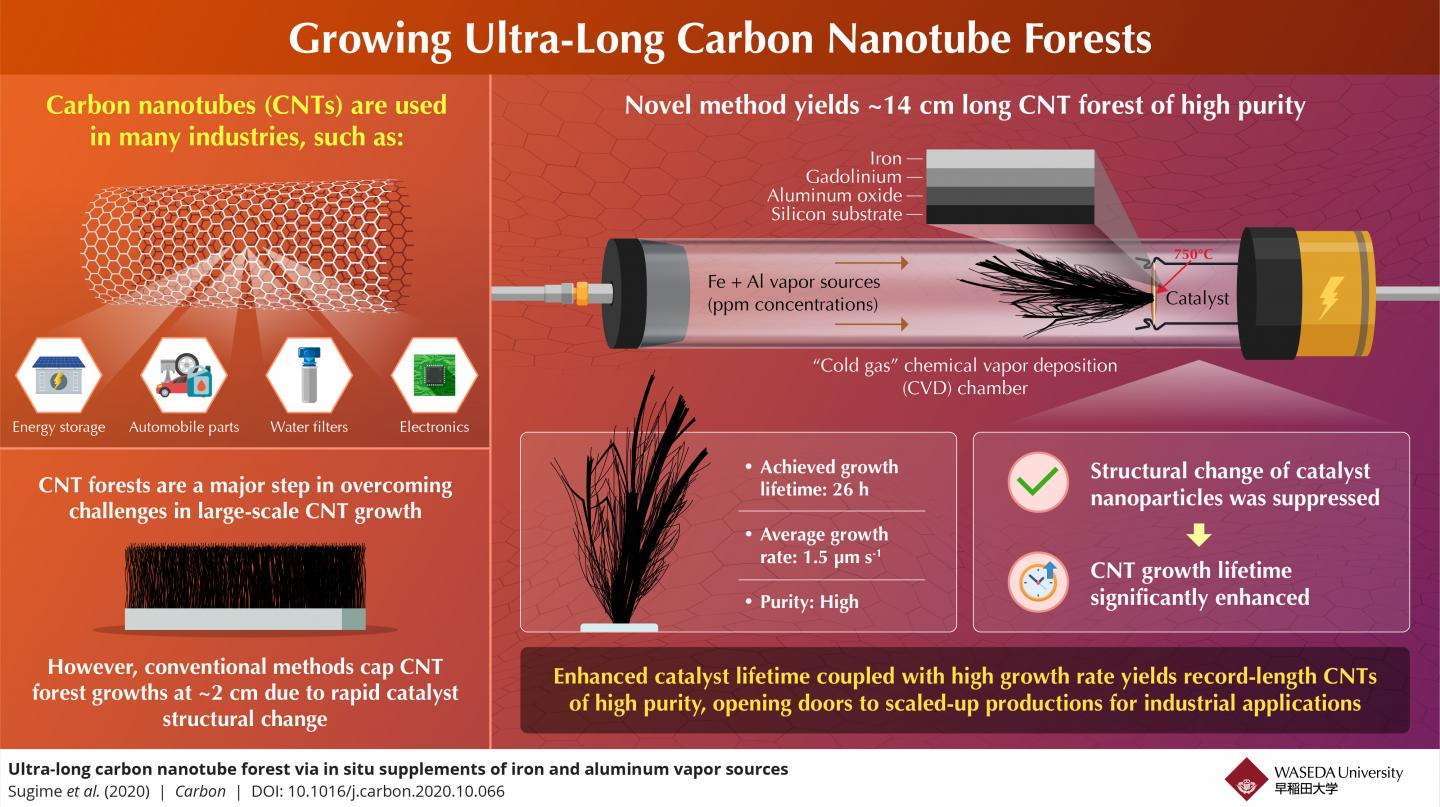Nov 5 2020
Currently, a wide range of industries, such as electronics, optics, drug delivery, and water purification, employ nanometer-wide rolls of honeycomb-shaped graphite sheets known as carbon nanotubes (CNTs) to achieve innovations at a scale like never before.
 Scientists from Japan have proposed a way to ensure longer catalyst lifetime and higher growth rate, creating a CNT forest that is a record seven times longer than any existing CNT array. Image Credit: Waseda University.
Scientists from Japan have proposed a way to ensure longer catalyst lifetime and higher growth rate, creating a CNT forest that is a record seven times longer than any existing CNT array. Image Credit: Waseda University.
CNTs exhibit features like convenient structure, a light weight, superior thermal and electrical conductivities, stability, and robust mechanical strength. Thus, they have an edge over other material alternatives.
But to meet their ever-increasing industrial demand, it is crucial to scale up their production continuously, wherein lies the principal challenge of using CNTs.
While researchers have been able to develop individual CNTs with lengths of around 50 cm, efforts to achieve arrays or forests stop at approximately 2 cm.
The reason is the catalyst, which is essential to CNT growth, deactivates, and/or runs out before CNTs in a forest can grow longer. This increases the monetary and raw-material expenses of CNT production and threatens to end its industrial usage.
A group of scientists from Japan has now developed a groundbreaking approach. In a paper published in the journal Carbon, the researchers describe an innovative approach to a traditional method that produces CNT forests of record length: approximately14 cm, which is seven times greater compared to the maximum value achieved earlier.
In the conventional technique, the CNTs stop growing due to a gradual structural change in the catalyst, so we focused on developing a new technique that suppresses this structural change and allows the CNTs to grow for a longer period.
Hisashi Sugime, Leader of the Team and Assistant Professor, Waseda University
To start with, the researchers made a catalyst by applying the results of an earlier study. Then, they added a gadolinium (Gd) layer to the traditional iron-aluminum oxide (Fe/Al2Ox) catalyst coated onto a silicon (Si) substrate. The Gd layer stopped the deterioration of the catalyst to some extent, thus enabling the forest to grow up to about 5 cm in length.
To inhibit further deterioration of the catalyst, the researchers positioned the catalyst in their original chamber known as the cold-gas chemical vapor deposition (CVD) chamber. The catalyst was heated to 750 °C and provided it with small concentrations (parts-per-million) of room temperature Fe and Al vapors.
This helps the catalyst to run stably for 26 hours, which enabled a dense CNT forest to grow up to 14 cm. Several studies to characterize the grown CNTs demonstrated that they were of competitive strength and high purity.
This success not only helps overcome obstacles to the extensive industrial application of CNTs but also paves the way for research in nanoscience.
This simple but novel method that drastically prolongs catalyst lifetime by supplying ppm-level vapor sources is insightful for catalyst engineering in other fields such as petrochemistry and nanomaterial crystal growth. The knowledge herein could be pivotal to making nanomaterials a ubiquitous reality.
Hisashi Sugime, Leader of the Team and Assistant Professor, Waseda University
Journal Reference:
Sugime, H., et al. (2020) Ultra-long carbon nanotube forest via in situ supplements of iron and aluminum vapor sources. Carbon. doi.org/10.1016/j.carbon.2020.10.066.